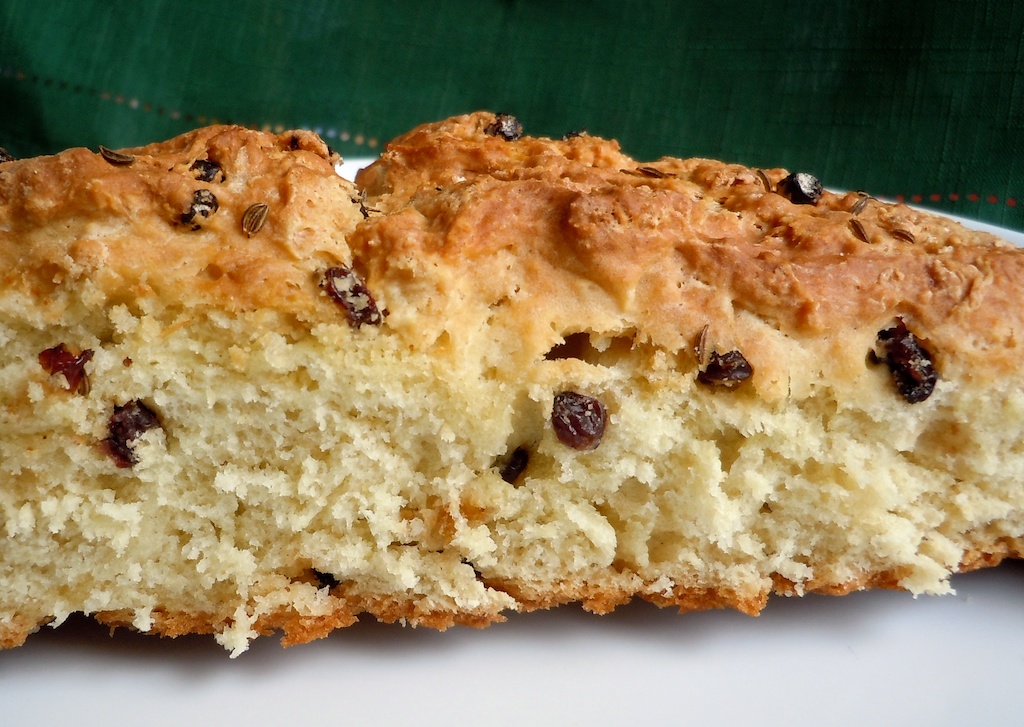 Every year on March 17, many Americans channel their inner Irish…wait, I’m not even going to dignify it with that kind of phrasing. A number of Americans use St. Patrick’s Day, like many other holidays, as an excuse to overindulge. They drink – a lot. And it’s ridiculous because the celebration of Irish culture is more than green beer. It is more than corned beef and cabbage (just what is “corned,†anyway?).
Every year on March 17, many Americans channel their inner Irish…wait, I’m not even going to dignify it with that kind of phrasing. A number of Americans use St. Patrick’s Day, like many other holidays, as an excuse to overindulge. They drink – a lot. And it’s ridiculous because the celebration of Irish culture is more than green beer. It is more than corned beef and cabbage (just what is “corned,†anyway?).
 Some of us really know what it means to channel our inner Irish. The approach is not as willy nilly as slapping on green antennae and calling it good. What I have come to know and feel as the spirit of St. Patrick’s Day is about heart and soul and strength, like the Claddagh I sometimes pin to my lapel or wear on my toe. It is about the small town in Kansas from where I come — founded by Irish — and the green lighted shamrock from that town’s hardware store that I hang on my door each year in tribute. It is about that town’s strength, heart and spirit that survived being nearly decimated by a tornado a few years back, and the national attention that drew one bloated university to demand my town give up its fighting leprechaun mascot .
Some of us really know what it means to channel our inner Irish. The approach is not as willy nilly as slapping on green antennae and calling it good. What I have come to know and feel as the spirit of St. Patrick’s Day is about heart and soul and strength, like the Claddagh I sometimes pin to my lapel or wear on my toe. It is about the small town in Kansas from where I come — founded by Irish — and the green lighted shamrock from that town’s hardware store that I hang on my door each year in tribute. It is about that town’s strength, heart and spirit that survived being nearly decimated by a tornado a few years back, and the national attention that drew one bloated university to demand my town give up its fighting leprechaun mascot .
 St. Patrick’s Day is about everything I love: my hometown, my homeland across the sea, the color green, whimsy and song, having a laugh, telling a story. The storytelling may be the best of it, as it brings all the loves together. I make my way each year on St. Patrick’s Day to favorite Irish stories, one of them being a remarkable film called “The Secret of Roan Inish,†by the brilliant director and writer John Sayles. The film is a celebration of story, of strength, of the undeniable pull toward home, where the heart truly is.
St. Patrick’s Day is about everything I love: my hometown, my homeland across the sea, the color green, whimsy and song, having a laugh, telling a story. The storytelling may be the best of it, as it brings all the loves together. I make my way each year on St. Patrick’s Day to favorite Irish stories, one of them being a remarkable film called “The Secret of Roan Inish,†by the brilliant director and writer John Sayles. The film is a celebration of story, of strength, of the undeniable pull toward home, where the heart truly is.
The heart of my home away from home would be my oven (well, after my rabbit, that is). It brings alive the senses and imagination and celebrates story and tradition all year long. For St. Patrick’s Day, I brought from my oven Irish soda bread, which is, like many things Irish, sturdy and hearty, seemingly simple, but satisfying in a uniquely Irish way. I have made soda bread in the past and decided to offer here two versions – one very traditional and purist; the other a more contemporary update that rings a little sweeter and lighter.
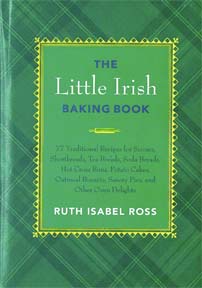 From a diminutive little green cookbook, “Little Irish Baking Book
From a diminutive little green cookbook, “Little Irish Baking Book ,†by Ruth Isabel Ross (1995), comes a traditional Brown Soda Bread. Ross explains that soda bread falls under the category of “country breads,†those “made without yeast, leavened by bread/baking soda or baking powder.†Making such a bread, Ross says, “gives us a feeling of continuity with the past.â€
Truly, as I assembled the very modest and simplistic elements of the Brown Soda Bread from Ross’ book, I felt a connection with my hardy and humble forebears across the sea, who lived off the ballast of dense, weighty loaves, made with precious few resources.
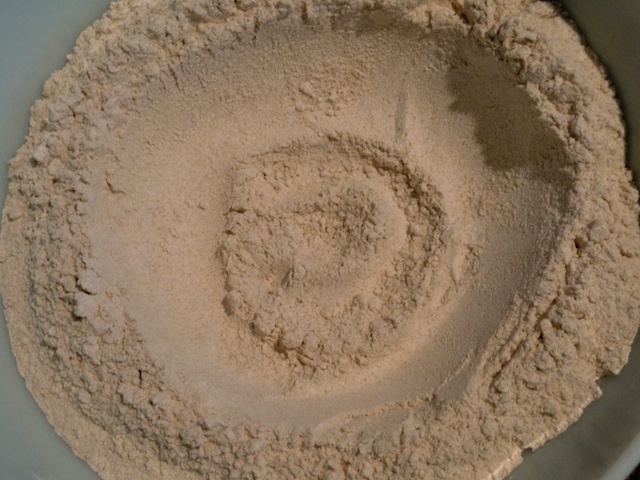 This soda bread uses mostly whole wheat flour, some white flour. baking soda, salt and buttermilk. That’s it. The dry ingredients are assembled, and I found it quite meditative (actually, I was in a bit of a trance) to circle my spoon in the dry mix to make the well for the buttermilk (like those desktop “zen gardensâ€). It comes together quickly, but not without some muscle required to knead it into submission. Something Old World enveloped me as I cut a cross in the claylike round of dough.
This soda bread uses mostly whole wheat flour, some white flour. baking soda, salt and buttermilk. That’s it. The dry ingredients are assembled, and I found it quite meditative (actually, I was in a bit of a trance) to circle my spoon in the dry mix to make the well for the buttermilk (like those desktop “zen gardensâ€). It comes together quickly, but not without some muscle required to knead it into submission. Something Old World enveloped me as I cut a cross in the claylike round of dough.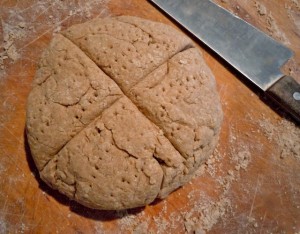
As it bakes, the dough cross opens up a bit, like a craggy Irish cliff. The bread itself is very dense and very heavy, but eaten warm from the oven, a slice slathered in Kerrygold Butter (imported from Ireland) is a treat, like a wheat biscuit with bit of crunch on the crust, giving way to a tender graininess, earthy and robust.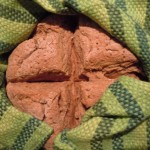
Brown Soda Bread
From “The Little Irish Baking Book†by Ruth Isabel Ross (1995)
1 cup white (all-purpose) flour
3 cups coarse brown (whole wheat) flour
1 ½ teaspoon bread (baking) soda
1 ¼ teaspoon salt
1 ¼ cups buttermilk
Mix all the dry ingredients in a large mixing bowl. Make a well in the centre and add the buttermilk gradually, using a knife to mix.
As soon as a dough is formed, turn it out onto a floured board and knead it lightly. It should become soft and elastic.
Form a round loaf. Prick it with a fork and cut a deep cross in the top of the loaf.
Place on a baking sheet and bake at 400 degrees for 35 minutes. The loaf should sound hollow, top and bottom, when fully cooked. .
Wrap the loaf immediately in a clean tea towel/dish cloth and put it on a rack to cool.
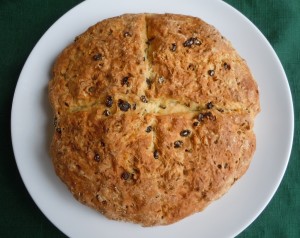 My second offering of soda bread differs from the first in a few ways. Overall, it is a daintier, less scrappy version than its traditional counterpart. It is baked in a pan, whereas the Brown Soda Bread is baked on a sheet. It uses all white flour and a number of additional ingredients, including baking powder, sugar, butter and an egg. With the addition of sugar and dried fruits, this becomes more of a tea bread. Its extra leavening adds more lift; the butter and egg lend tenderness. Like a giant scone (made by “A Woman Sconed†with an Irish heart), it is delicious with any buttery spread, Devonshire cream, jam or honey.
My second offering of soda bread differs from the first in a few ways. Overall, it is a daintier, less scrappy version than its traditional counterpart. It is baked in a pan, whereas the Brown Soda Bread is baked on a sheet. It uses all white flour and a number of additional ingredients, including baking powder, sugar, butter and an egg. With the addition of sugar and dried fruits, this becomes more of a tea bread. Its extra leavening adds more lift; the butter and egg lend tenderness. Like a giant scone (made by “A Woman Sconed†with an Irish heart), it is delicious with any buttery spread, Devonshire cream, jam or honey.
Irish Currant Soda Bread
From “Sunset Breads†(1984)
Makes 2 loaves
4 to 4 ½ cups all-purpose flour
1 teaspoon salt
3 teaspoons baking powder
1 teaspoon baking soda
¼ cup sugar (optional)
1/8 teaspoon ground cardamom or coriander (optional)
¼ cup firm butter or margarine
2 cups currants or raisins
1 ¾ cups buttermilk
1 ¼ teaspoons caraway seeds (optional)
In a large bowl, stir together 4 cups of the flour, the salt, baking powder, and baking soda (and sugar and cardamom, if used) until thoroughly blended. Cut in butter with a pastry blender or 2 knives until crumbly. Add currants or raisins. In a separate bowl, beat egg lightly and mix with the buttermilk; stir into dry ingredients until blended. Turn out onto a floured board and knead until smooth (2 to 3 minutes).
Divide dough in half and shape each half into a smooth, round loaf, place each loaf in a greased 8-inch cake or pie pan and press to make dough fill pans. With a razor blade or sharp knife, cut a ½-inch deep cross in top of each loaf. Sprinkle with caraway seeds, if desired.
Bake in a preheated 375-degree oven (350 for glass pans) for 35 to 40 minutes or until nicely browned.